Thursday, April 15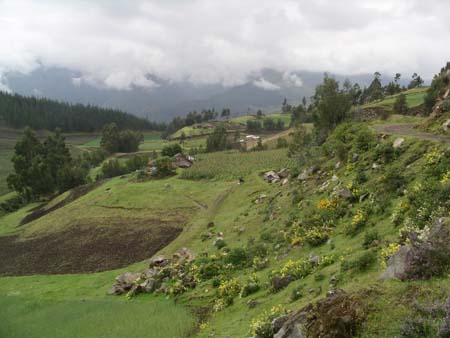
Steve: Today we visited Hacienda Zuleta, a 4,000 acre
farm that dates from the 16th century and sits in a spectacular setting in
the Andean mountains. This estate has been owned for over 100 years by a family
that has produced two of Ecuador's presidents. It's also home to over 1,200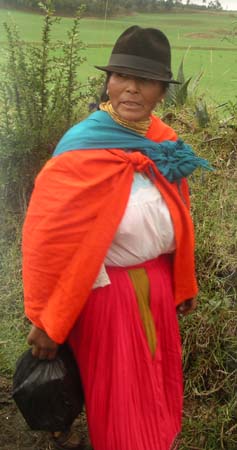 cows that are used for dairy products, and over 3,000 sheep. Zuleta actually
also has a small number of guest rooms, but we made arrangements to visit
for the day.
cows that are used for dairy products, and over 3,000 sheep. Zuleta actually
also has a small number of guest rooms, but we made arrangements to visit
for the day.
The route to Zuleta was on a narrow and winding mountain road that took us
past many beautifully green farms, all owned by Indian families that are native
to this area. The primary crop grown here is corn, and this region's wonderful
climate enables four full crops per year. Other major crops include potatoes,
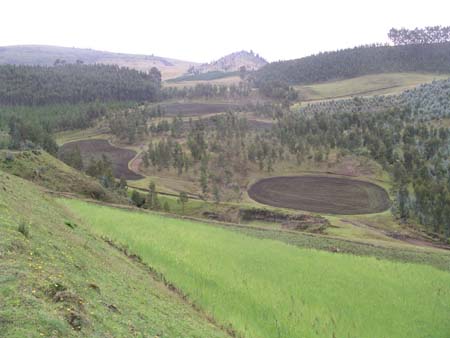 peas, and wheat. The farms have all been passed down within families over
hundreds of years, and the rich volcanic soil is extremely productive. Our
drive through these farmlands was exceptionally beautiful, and we enjoyed
seeing the traditionally-dressed women and children along the road. Unfortunately,
we're finding the people here to be very camera-shy, so we haven't been able
to take the kind of photographs we've been used to getting in Asia (we did
manage this one shot above taken from the window of our van). We'll have to
keep working on
peas, and wheat. The farms have all been passed down within families over
hundreds of years, and the rich volcanic soil is extremely productive. Our
drive through these farmlands was exceptionally beautiful, and we enjoyed
seeing the traditionally-dressed women and children along the road. Unfortunately,
we're finding the people here to be very camera-shy, so we haven't been able
to take the kind of photographs we've been used to getting in Asia (we did
manage this one shot above taken from the window of our van). We'll have to
keep working on 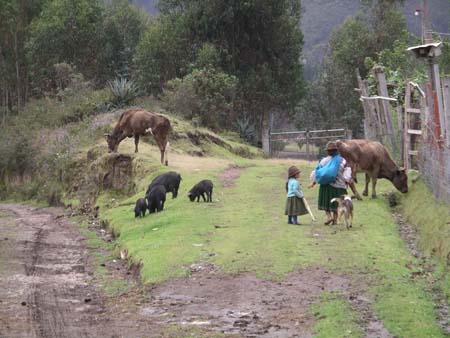 that…
that…
Along the way, Henry also shared with us some more information about the
Indians who live here. They represent 35% of Ecuador's overall population,
and appear to be very self-sufficient. There are actually 250 ethnic Indian
"communities", all living very traditional lifestyles. Henry indicated
that family sizes are typically 10-12 (most are very strict Catholics, and
do not use birth control), with most people marrying at 18-19 years of age
(much older than most of the ethic minorities we encountered in Asia). Each
family farms roughly 5-10 acres of land, most of which was given to them by
Ecuador's government in 1950. Interestingly, the Indians don't pay any taxes
to the government. They rarely use public medical facilities, preferring instead
to use traditional treatments in their homes.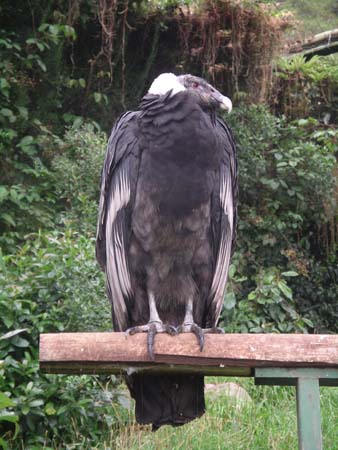
After arriving at Zuleta, we first visited the Andean Condor Rescue project that the owners of this hacienda started five years ago. David has described the details of this unique effort below, and we greatly enjoyed learning about and actually seeing one of these magnificent birds flying in the wild today. The setting for the condor project is spectacular - it looks out over a lush green valley in one direction and into a deep mountain canyon in the other. The project has been intentionally located in an area where the wild birds still fly. The rescued birds are kept in a large cage which actually attracts many of the wild condors that sometimes come to investigate the captive birds. Patience paid off for us today, as we were rewarded with a wonderful opportunity to see a rare Andean Condor soaring high over the ridges of the canyon.
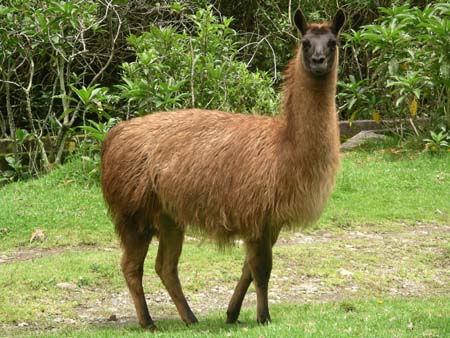 It
was also fun to explore some of the other animals that reside here, including
cows, llamas (we thought that this one was particularly handsome!), and trout
that are farmed in large ponds. We also did some more bird watching, and were
lucky to see a rare White Tail Tyrant Flycatcher - this is a bird that's in
danger of extinction.
It
was also fun to explore some of the other animals that reside here, including
cows, llamas (we thought that this one was particularly handsome!), and trout
that are farmed in large ponds. We also did some more bird watching, and were
lucky to see a rare White Tail Tyrant Flycatcher - this is a bird that's in
danger of extinction.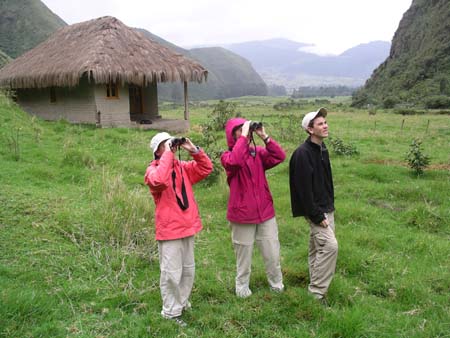
We were treated to a wonderful lunch, with the highlight being a local soup
called "Quinoa". It's made from a cereal of the same name, and also
contains potatoes and cream. It was absolutely delicious, and we 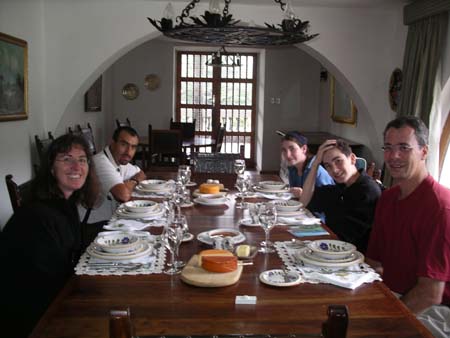 enjoyed
two full bowls each! Dessert was local fruit called "babaco", that's
served in sweet syrup. As usual, we always love partaking in traditional foods
in the places we visit - this always seems to turn into a very rewarding experience.
enjoyed
two full bowls each! Dessert was local fruit called "babaco", that's
served in sweet syrup. As usual, we always love partaking in traditional foods
in the places we visit - this always seems to turn into a very rewarding experience.
After lunch, we took a tour of the main home at Hacienda Zuleta.  The
house is built in a traditional "Colonial Spanish" design, referring
to styles popular here in the 16th and 17th centuries. Its wooden beams
The
house is built in a traditional "Colonial Spanish" design, referring
to styles popular here in the 16th and 17th centuries. Its wooden beams 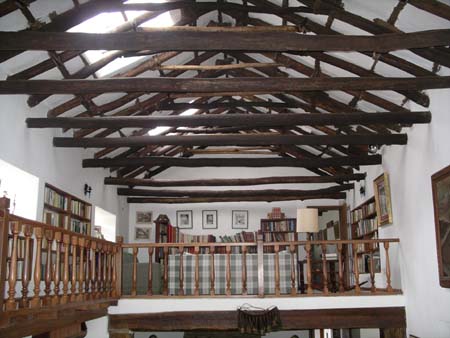 are
all original, and are held together with leather straps - no nails were used.
Zuleta has only opened its doors recently to outside guests, and it was lovely
to walk through its many rooms.
are
all original, and are held together with leather straps - no nails were used.
Zuleta has only opened its doors recently to outside guests, and it was lovely
to walk through its many rooms.
Upon leaving Zuleta, we stopped to look at some of the man-made mounds that
dot the countryside. These date from the 13th 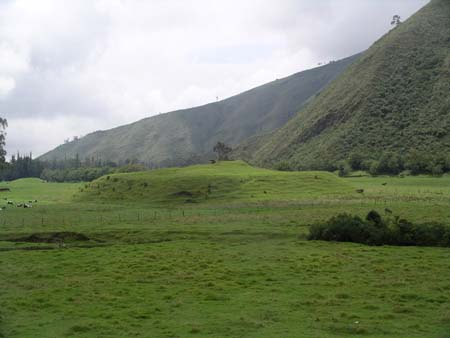 century,
and were constructed by the Caranquis tribe that lived here. They came in
three sizes - the largest for religious ceremonies, a middle-size that houses
were built on and a smaller mound used for burials. These mounds are all grass-covered
today, but it's still possible to see the outline of the adobe brick pyramids
that still exist underneath.
century,
and were constructed by the Caranquis tribe that lived here. They came in
three sizes - the largest for religious ceremonies, a middle-size that houses
were built on and a smaller mound used for burials. These mounds are all grass-covered
today, but it's still possible to see the outline of the adobe brick pyramids
that still exist underneath.
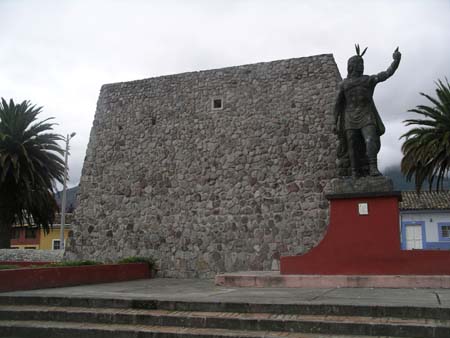 Finally,
we stopped in the town of Caranquis. This is where Atahaulpa, the last Inca
emperor, was born. We took a picture of a large monument and statue dedicated
to Atahaulpa.
Finally,
we stopped in the town of Caranquis. This is where Atahaulpa, the last Inca
emperor, was born. We took a picture of a large monument and statue dedicated
to Atahaulpa.
Tomorrow we plan to visit several local weaving villages, and to also ride bikes in the area surrounding our hacienda. We're still in Ecuador's rainy season, and so far we've had rain each afternoon (mornings have been cloudy, but dry). We're hoping that tomorrow is dry for the entire day so that we can get both of these activities in.
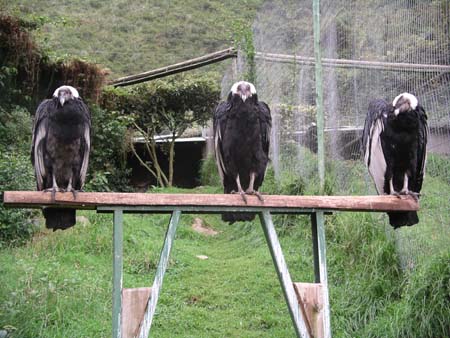
David's Daily Dump: The Andean Condor Rescue Project. Today we visited
a magnificent Andean Condor project in the small town of Zuleta. This effort
to save the Condor from extinction has been going on in this hacienda for
the past six years. The condors have been rescued from people's homes (where
farmers sometimes keep them as pets), hotels, and even zoos from all over
the country. In all there are fifteen condors in captivity kept in relatively
large cages (compared to their old ones with farmers) out near the mountains
were they can slowly get used to the region.
The founders of this project hope to gradually introduce the condors back to the wild with the other wild condors. There are only about 70 wild Andean Condors left in Ecuador and they are extremely close to extinction. We were lucky enough to spot one overhead curiously circling the caged condors.
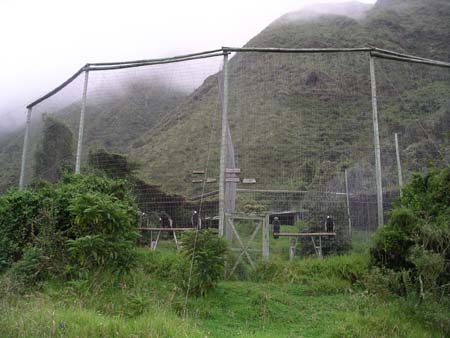 These
huge birds can weigh up to 25 lbs and can have wingspans over 10 ft! They
are among the largest living birds on earth and very beautiful (actually they
are kind of fierce and ugly looking). The condors are members of the vulture
family and only prey on dead animals, although they occasionally attack small
wounded animals. In fact this is a common misconception among the Indians
in the rural areas of Ecuador. Some of the farmers believe that the condors
kill their livestock and may even carry away their small children. Because
of this many of the birds are shot and wounded. This is why they are so close
to extinction. This project has saved many of these wounded condors and is
attempting to inform the farmers that the condors will do nothing to hurt
their animals or children. I enjoyed visiting these neat birds and am glad
that an effort is being made to help these Andean Condors evade extinction.
These
huge birds can weigh up to 25 lbs and can have wingspans over 10 ft! They
are among the largest living birds on earth and very beautiful (actually they
are kind of fierce and ugly looking). The condors are members of the vulture
family and only prey on dead animals, although they occasionally attack small
wounded animals. In fact this is a common misconception among the Indians
in the rural areas of Ecuador. Some of the farmers believe that the condors
kill their livestock and may even carry away their small children. Because
of this many of the birds are shot and wounded. This is why they are so close
to extinction. This project has saved many of these wounded condors and is
attempting to inform the farmers that the condors will do nothing to hurt
their animals or children. I enjoyed visiting these neat birds and am glad
that an effort is being made to help these Andean Condors evade extinction.
Katie's Kwick Kwacks: My Impressions of Our First Day in a Japanese Home.
My experience with our home stay visit was one of the best and most interesting
experiences on the trip for me. This unique opportunity allowed us the chance
to stay with a Japanese family and be a part of every day life in rural Japan.
The following paragraphs describe my experience with this home 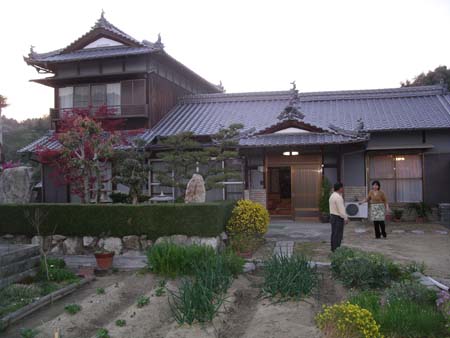 stay,
and what I learned from it.
stay,
and what I learned from it.
As we stepped off the small train at the Imabari station, I didn't know what to expect. This was the part of our visit to Japan that I had looked forward to most, yet I was still very nervous. This part was not planned. I couldn't ask Dad to clarify anything. We were going to a village and staying with some families connected to a student exchange program in California-that's all anyone knew. Before that day, I had dreamed of walking into a traditional Japanese home and a staying with a cozy family. Now, however, I wasn't so sure. On our way to Asakura I had seen only crammed buildings and factories through the train window, and was now afraid our small village was about to become a big industrialized city. When we met up with our home stay hosts, we hopped in a big van and drove into the city. All I could see at that point was city, but after about 15 minutes, I could tell we were moving into the mountains. Before I knew it we were in the village, driving among hundreds of small traditional homes and gardens. The first trace of a smile crossed over my face.
.jpg) Indeed,
my home was just as I had imagined it in my dreams. The woman had a beautiful
vegetable and flower garden in her front yard, and her house was absolutely
wonderful. It had a traditional gray tile roof with many beautiful ridges.
The best part was the dragon fish and other gargoyle creatures sticking off
the sides of the roof. We could have spent fifteen minutes just exploring
the beautiful design of her little home. When we got inside, Mom and I took
off our shoes and changed into slippers. Mitsuko, our host, ushered us in,
and we walked onto a puzzle of traditional straw woven mats called tatami.
Now I was getting excited. We were going to sleep on a straw mat floor. We
walked around the small house and observed all of places where we would change
our slippers. There were sets at the front door, one pair in the bathroom,
two pairs outside our room, and four sets in the kitchen.
Indeed,
my home was just as I had imagined it in my dreams. The woman had a beautiful
vegetable and flower garden in her front yard, and her house was absolutely
wonderful. It had a traditional gray tile roof with many beautiful ridges.
The best part was the dragon fish and other gargoyle creatures sticking off
the sides of the roof. We could have spent fifteen minutes just exploring
the beautiful design of her little home. When we got inside, Mom and I took
off our shoes and changed into slippers. Mitsuko, our host, ushered us in,
and we walked onto a puzzle of traditional straw woven mats called tatami.
Now I was getting excited. We were going to sleep on a straw mat floor. We
walked around the small house and observed all of places where we would change
our slippers. There were sets at the front door, one pair in the bathroom,
two pairs outside our room, and four sets in the kitchen.
After settling in, we visited a towel museum, went strawberry picking, and
had tea, meeting many of our hosts' neighborhood friends along the way. We
had a wonderful dinner, and even learned some new Japanese customs. We sat
on small cushions on the straw mats in the house, and followed the actions
of our host. We learned not to point your feet at anyone and that women had
to sit on their knees (this is very uncomfortable after long periods). We
had a big pot where our host fried pieces of beef, mushrooms, tofu, and other
foods. We then cracked a raw egg in our bowls, and dipped the food in it to
eat. It was called suki-yaki and was a very different meal from anything we
have had in Japan. A couple of times we made the mistake of saying we liked
a particular food on the platter. If our host ever heard us say this, she
would quickly prepare more of that item, and we would be stuck with more than
we could eat. 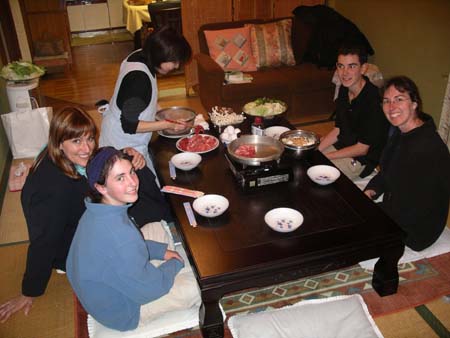
There was also one embarrassing incident where I asked David to pass me some mushrooms. He gave me some with his chopsticks and I picked them up with mine. Mitsuko gave us a frightening look and we figured this was not the most polite thing to do. We later learned (much to our surprise) that she was not upset because it was impolite, but rather because we had just performed a superstitious ritual. Passing food between one another's chopsticks, we were told by our friend, was an action done when someone in the family has died. What luck! Besides those two things, I think we did pretty well for our first meal in a Japanese home.
After dinner Mom and I had the opportunity to take a traditional bath. In
Japan these are essential not only for cleanliness, but more importantly for
relaxation. After having a brief explanation from my host on how to use the
bath (this was mostly communicated to me through a series of gestures), I
was ready to begin. The bathroom was a small square room (separate from the
toilet and sink) includi.jpg) ng
a shower nozzle, plastic stool, water bucket, a couple of washing sponges,
rough hand towels, soap and shampoo, and a large tub. Mitsuko had taught me
the order of washing already, so I knew where to start. I first began by picking
up the shower nozzle and soap, and sitting on the low stool. I then rubbed
soap all over and rinsed with the nozzle. She had told me with her little
English to wash with cold water first, but I decided to skip this step. I
then scrubbed all over my body with a rough towel and sponge before filling
up the water bucket and pouring it down my back. After washing my hair with
shampoo I was ready to begin the most important part of the procedure: the
tub soak. When Mitsuko first showed me to the room, I found the tub already
full of green water-this was the original color coming from the tap. When
I stepped in, I found it to be very hot and a lot deeper than it had looked.
Mitsuko said that many people soak in their tub for over an hour, but I decided
on just a couple minutes. It was very soothing and the water had a pretty
fragrance. I got out feeling sleepy and ready for bed. Before going to my
sleeping spot, however, I decided to go and talk with Mitsuko for a minute.
ng
a shower nozzle, plastic stool, water bucket, a couple of washing sponges,
rough hand towels, soap and shampoo, and a large tub. Mitsuko had taught me
the order of washing already, so I knew where to start. I first began by picking
up the shower nozzle and soap, and sitting on the low stool. I then rubbed
soap all over and rinsed with the nozzle. She had told me with her little
English to wash with cold water first, but I decided to skip this step. I
then scrubbed all over my body with a rough towel and sponge before filling
up the water bucket and pouring it down my back. After washing my hair with
shampoo I was ready to begin the most important part of the procedure: the
tub soak. When Mitsuko first showed me to the room, I found the tub already
full of green water-this was the original color coming from the tap. When
I stepped in, I found it to be very hot and a lot deeper than it had looked.
Mitsuko said that many people soak in their tub for over an hour, but I decided
on just a couple minutes. It was very soothing and the water had a pretty
fragrance. I got out feeling sleepy and ready for bed. Before going to my
sleeping spot, however, I decided to go and talk with Mitsuko for a minute.
When I got to the kitchen much there was a big bowl of freshly picked strawberries
sitting on the table, and Mitsuko told me to sit .jpg) down
and eat them. In addition she brought me some strange sardine-like crackers,
which after trying one, I decided not to touch. She kept on asking me if I
was cold, and whenever I hesitated a bit in misunderstanding, she would turn
her small heater up a notch. She eventually sat down with me, and we began
to try and have a conversation. She had a miniature translator which she used
to look up necessary words. When communicating with me, she would first say
the sentence in Japanese and then try in English. I think she may have been
trying to teach me some of the language, but this proved to be unsuccessful.
Her voice and face were so soft and comforting, and I never knew I could feel
so comfortable in a Japanese home and with a foreign woman. It was a great
feeling, and I wish I could have communicated my message to her. Later on
in our talk, she pulled out a black folder which contained some of her English
homework. I helped her study each of the phrases but realized right away that
she had used her device to directly translate the words, and they were therefore
grammatically incorrect. We still had a great time, and I think she enjoyed
learning from an American kid for a change.
down
and eat them. In addition she brought me some strange sardine-like crackers,
which after trying one, I decided not to touch. She kept on asking me if I
was cold, and whenever I hesitated a bit in misunderstanding, she would turn
her small heater up a notch. She eventually sat down with me, and we began
to try and have a conversation. She had a miniature translator which she used
to look up necessary words. When communicating with me, she would first say
the sentence in Japanese and then try in English. I think she may have been
trying to teach me some of the language, but this proved to be unsuccessful.
Her voice and face were so soft and comforting, and I never knew I could feel
so comfortable in a Japanese home and with a foreign woman. It was a great
feeling, and I wish I could have communicated my message to her. Later on
in our talk, she pulled out a black folder which contained some of her English
homework. I helped her study each of the phrases but realized right away that
she had used her device to directly translate the words, and they were therefore
grammatically incorrect. We still had a great time, and I think she enjoyed
learning from an American kid for a change.
.jpg) When
I was about to go to bed, however, she seemed unsatisfied with something.
I sat for a second, and she finally said, "Did you relax in bath"?
She seemed really nervous as she said it, and I realized Japanese people don't
like to make mistakes. I looked at her and said back, "Yes, I did."
She gave me a wonderful smile, and her face immediately lit up in delight.
We exchanged slight bows and said goodnight. When I got in my sleeping spot
the beds were already made up. As I slipped under the covers I noticed a thick
robe on the mat. I chuckled to myself. I pulled the covers up to my chin and
sank into the soft mattress. It was plenty warm. As I drifted into sleep,
I wondered why Japan had felt so foreign to me. This place felt just like
home.
When
I was about to go to bed, however, she seemed unsatisfied with something.
I sat for a second, and she finally said, "Did you relax in bath"?
She seemed really nervous as she said it, and I realized Japanese people don't
like to make mistakes. I looked at her and said back, "Yes, I did."
She gave me a wonderful smile, and her face immediately lit up in delight.
We exchanged slight bows and said goodnight. When I got in my sleeping spot
the beds were already made up. As I slipped under the covers I noticed a thick
robe on the mat. I chuckled to myself. I pulled the covers up to my chin and
sank into the soft mattress. It was plenty warm. As I drifted into sleep,
I wondered why Japan had felt so foreign to me. This place felt just like
home.
